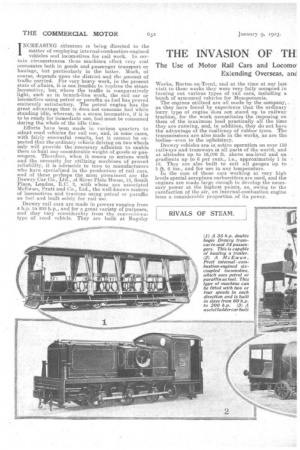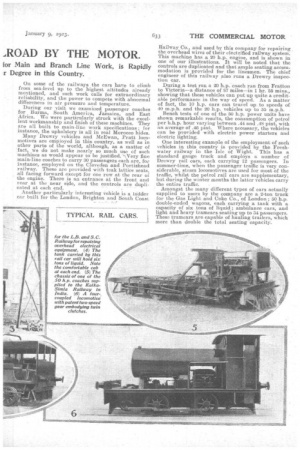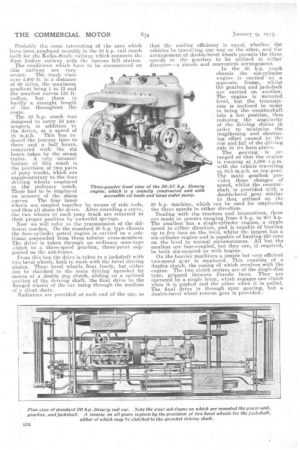THE INVASION OF TH. ,ROAD BY THE MOTOR.
Page 18

Page 19

Page 20

If you've noticed an error in this article please click here to report it so we can fix it.
The Use of Motor Rail Cars and Locomcc
Extending. Overseas, anc. for Main and Branch Line Work, is Rapidly r Degree in this Country.
INCREASING Sz.ttention is being directed to the matter of employing internal-combustion-engined . vehicles and locomotives for rail work. In certain circumstances these machines effect very real economies both in goods and passenger transport or haulage, but particularly in the laater. Much, of course, depends upon the district and the amount of traffic carried. For very heavy work, in the present state of affairs, it is not feasible to replace the steam locomotive but, where the traffic is comparatively light, such as in branch-line work, the rail car or locomotive using petrol or paraffin as fuel has proved eminently satisfactory. The petrol engine has the great advantage that it does not consume fuel while standing idle, whereas, in a steam locomotive, if it is to be ready for immediate use, fuel must be consumed during the whole of the idle time.
Efforts have been made in various quarters to adapt road vehicles for rail use, and, in some cases, with fairly successful results, but it cannot be expected that the ordinary vehicle driving on two wheels only will provide the 'necessary adhesion to enable them to haul any considerable weight of goods or passengers. Therefore, when it comes to serious work and the necessity for utilizing machines of proved reliability,it is advisable to turn to manufacturers who have specialized in the production of rail cars, and of these perhaps the most prominent are the Drewry Car Co., Ltd., of River Plate House, 13, South Place, London, E.C. 2, with whom are associated MeEwan, Pratt and Co. Ltd., the well-known makers of locomotives and tractors using petrol or paraffin as fuel and built solely for rail use.
Drewry rail cars are made in powers ranging from 4 h.p. to 200 h.p., and for a great variety of purposes, and they vary considerably from the conventional type of road vehicle. They are built at Baguley Works, Burton-on-Trent, and at the time of our last visit to these works they were very fully occupied in turning out various types of rail cars, including a batch of armoured vehicles for Mesopotamia.
The engines utilized are all made by the company, . as they have found by experience that the ordinary lorry type of engine does not stand up to railway traction, for the work necessitates the imposing on them of the inaximum load practically all the time they are running, and, in addition, they do not have the advantage of the resiliency of rubber tyres. The transmissions are also made in the works, as are the bodies—even to the upholstery.
Drewry vehicles are in active operation on over 160 railways and tramways in all parts of the world, and at altitudes up to 16,000 It. above sea-level and on gradients up to 6 per cent., i.e., approximately 1 in ' i. They are also built to suit all gauges up to 5 ft. 6 ins., and for use in any temperature.
In the case of those ears working at very high levels special aeroplane carburetters are used, and the engines are made large enough to develop the necessary power at the highest points, as, owing to the rarefaction of the air, an internal-combustion engine loses a considerable proportion of its power. On some of the railways the ears have to climb from sea-level up to the highest altitudes already mentioned, and such work calls for extraordinary reliability, and the power to compete with abnormal differences in air pressure and temperature. During our visit we examined passenger coaches for Burma, South America, Jamaica, and East Africa. We were particularly struck with the excellent workmanship and finish of these machines. They are all built to main-line work specifications ; for instance, the upholstery is all in real Morocco hides.
Many Drewry vehicles and McEwa,n, Pratt locomotives are employed in this country, as well as in other partsof the world, although, as a matter of 'fact, we do not make nearly so much use of such machines as would appear to be justified. Very fine mainline coaches to carry 30 passengers each are, for instance, employed on the Cleveclen and Portishead railway. These are provided with teak lattice seats, all facing forward except for one row at the rear of the •engine. There is an entrance at the front and rear at the near si,de, and the controls are dupli cated at each end. ._ . _ Another particularly interesting vehicle is a ladder car built for the London, Brighton and South Coast
Railway Co., and used by this company-for repairing the overhead wires of their electrified railway system This machine has a 20 h.p., engine, and is shown in one of our illustrations. It will be noted that the controls are duplicated and that ample seating accommodation is provided for the linesmen. The chief engineer of this railway also runs a Drewry inspection car.
During a test run a 20 h.p. coach ran from Fratton to Victoria—a distance of $7 miles—in 1 hr. 55 mine., showing that these vehicles can put up quite a creditable performance in the way of speed. As a matter of fact, the 10 h.p. cars can travel up .to speeds of 40 m.p.h. and the 20 h.p. vehicles up to 55 m.p.h.
Bench tests of one of the 50 h.p. power units have shown remarkable results, the consumption of petrol per b.h.p. hour varying between .44 and .48 pint, with an average of .46 pint. Where necessary, the vehicles can be provided with electric power starters and electric lighting. One interesting example of the employment of such vehicles in this country is -provided by the Freshwater railway in the Isle of Wight. This has a standard gauge track and employs a number of Drewry rail cars, each carrying 12 passengers. In summer-time, when the passenger traffic is very considerable, steam locomotives are used for must of the traffic, whilst the petrol rail cars are supplementary, but during the winter months the latter vehicles carry the entire traffic. •
Amongst the many different types of cars actually supplied to users by the company arca 2-ton truck for the Gas Light and Coke Co., of London ; 50 h.p. double-ended wagons, each carrying a tank with a capacity of six tons of liquid ; ambulance cars, and light and heavy tramcars seating up to 34 passengers. These tramcars are capable of hauling trailers, which more than double the total seating capacity. Probably the most interesting of the cars which have been produced recently is the 50 h.p. rail coach built for the Kafka-Simla railway which connects the East Indian railway with the famous hill station.
The conditions which have to be encountered on this railway are very
severe. The track rises over 4,600 ft. in a distance of 60 miles, the maximum gradient being 1 in 13 and the smallest curves 130 ft. radius, but there is hardly a straight length of line throughout the route.
The 50 h.p. coach was designed to carry 16 passengers, in addition to the driver, at a speed of
is m.p.h. This has reduced the journey tine to three and a half hours, compared with the six hours taken by the steam trains. A very unusual feature of this coach is the provision of two pairs of pony trucks, which are supplementary to the four driving wheels employed in the ordinary coach. These had to be employed on account of the sharp
curves. The four inner wheels are coupled together by means of side rods, and thus all share the drive. After rounding a curve, the two wheels of each pony truck are returned to their proper position by powerful springs.
Now we will refer to the transmission of the different coaches. On the standard 20 h.p. type chassis the four-cylinder petrol engine is carried on a subframe suspended from three tubular cross-members. Tho drive is taken through an ordinary cone-type clutch to a three-speed gearbox, three-point supported on the sub-frame.
From this box the drive is taken to a jackshaft with two bevel wheels, both in mesh with the bevel driving pinion. These. bevel wheels float freely, but either can be clutched to the main driving sprocket by means of a double dog clutch, sliding on a splined portion of the driving shaft, the final drive to the flanged wheels of the car being through the medium of a silent chain.
Radiators are provided at each end of the car, so
that the cooling efficiency is equal, whether the vehicles be traveliing one way Or the other, and the arrangement of double-bevel wheels permits the three speeds in the gearbox to be utilized in either direction—a simple and convenient arrangement.
In the 50 h.p. coach chassis the six-cylinder i engine s carried on a separate frame, whilst the gearbox and jackshaft are carried on another. The engine is mounted level, but the transmis sion is inclined in order to bring the countershaft into a low position, thus reducing the angularity of the driving chains in order to minimize the lengthening and shortening effect caused by the rise and fall of the driving axle in its horn-plates. The gearing is arranged so that the engine
is running at 1,000 r.p.m.
with the vehicle travelling at 16.6 m.p.h. on top gear.
The main gearbox provides three changes of speed, whilst the countershaft Is provided with a , double-bevel gear similar to that utilized on the 20 h.p. machine, which can be used for employing the three speeds in either direction. Dealing with the 'tractors and locomotives, these are made in powers ranging from 6 h.p. to 2.00.h.p.
The smallest has a single-cylinder engine, a single speed in either direction, and is capable of hauling up to five tons on the level, whilst the largest has a six-cylinder engine and is capable of hauling 420 tons on the level in normal circumstances. All but the smallest are four-coupled, but they can, if required, • be built six-coupled orwith bogies. On the heavier machines a simple but very efficient two-speed gear is employed. This consists of a
duplex clutch, the casing of which revolves with the engine. The two clutch centres are of the single-disc type, gripped between Ferodo faces. They are operated by a single lover, which engages one clutch when it is pushed and the other when it is pulled. The final drive is through spur gearing, but a double-bevel wheel reverse gear is provided..
































